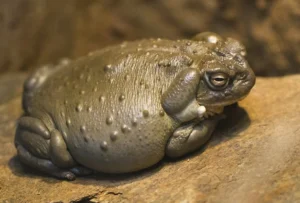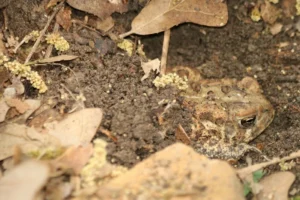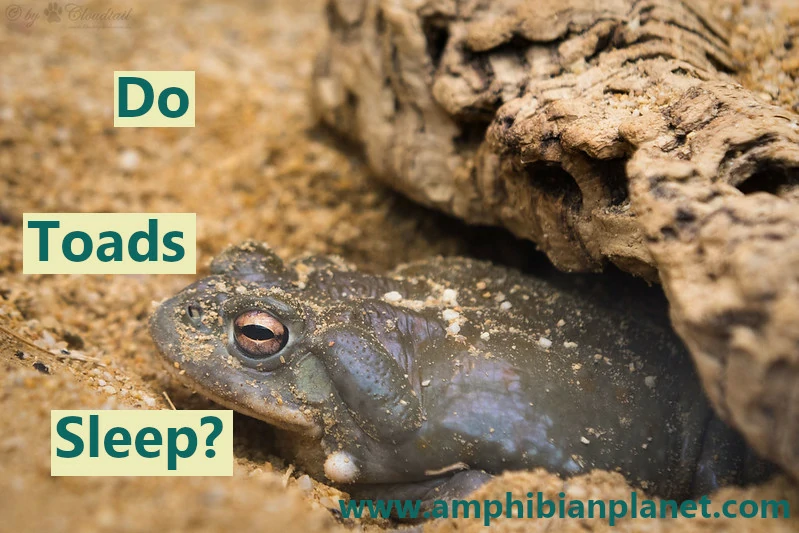Toads are intriguing creatures that attract the curiosity of many people. There are also many misconceptions about these animals.
In general, toads have 3 sleep-like states, namely cataleptic sleep, catatonic sleep, and cataplectic sleep. Cataleptic sleep appears mainly during the day, whereas Catatonic and Cataplectic sleep are observed during nighttime rest periods.
That said, it’s important to note that very few scientific studies have been carried out on the topic of toad sleep.
There are over 7,000 known frog and toad species on the planet, and less than 1% of these species have been studied in the context of sleep.
For this reason, what we currently know about the sleep behavior of toads is very limited, and may change in the future, with more scientific research.
What Exactly Is Sleep?
Put simply, sleep is a period of reduced activity that is characterized by changes in brain wave activity, breathing, heart rate, body temperature, and other physiological functions.
French scientist Henri Pieron proposed a behavioral definition in 1913. The behavioral features of sleep include:
- The spontaneous use of a stereotypic or species-specific posture during periods of immobility
- The maintenance of behavioral immobility,
- An elevated behavioral response threshold to arousal stimuli
- A rapid behavioral state reversibility upon stimulation
After the discovery of variation in brain waves related to sleep in humans, and other mammals, electrophysiological criteria were added to the definition of sleep.
Later on, a sleep state associated with rapid eye movements (REM sleep) was identified first in humans, and then in cats. This state was referred to as ‘paradoxical sleep’.
Following this discovery, electroencephalography, electromyography (EMG), and electro-oculography (EOG) were accepted as valid methods to identify sleep in mammals.
As a result, two main states are now recognized in mammals, as well as in birds: slow-wave sleep, also called non-REM sleep, or quiet sleep, and paradoxical sleep, also known as REM sleep or active sleep.
What We Know About Sleep In Toads
While both quiet sleep and active sleep have clearly been identified in mammals and birds, their presence in frogs and toads remains highly debated.
In 1982, Ida Gavrilovna Karmanova conducted a study to understand the evolution of sleep in vertebrates – and concluded that amphibians and fish show three forms of rest or sleep-like states (SLS), named ‘protosleep’ or ‘primary sleep’.
- Cataleptic (plastic muscle tone) or protosleep 1
- Catatonic (rigid muscle tone) or protosleep 2
- Cataplectic sleep (atonia)or protosleep 3
Cataleptic sleep appears mainly during the day when the eyes are open, whereas Catatonic and Cataplectic sleep are observed during nighttime rest periods.
The arousal threshold increases relative to the type of protosleep, and the heart rate decreases accordingly.
How Do Toads Sleep?
There are over 7,000 described frog and toad species, living in a wide range of habitats from trees to caves, to fast-flowing waterbodies.
For this reason, the exact sleeping posture, and behavior may vary among different toad species, that said, there are a few common behaviors that have been observed in several species of frogs when in a sleeping state.
Many toad species in a sleep state will be:
- Immobile
- Have their eyes closed
- Their limbs tucked under their body
- And their heads pointing downwards

When toads sleep, they generally close their translucent third eyelid, known as the nictitating membrane. Since this membrane is translucent, toads’ eyes may appear open when they sleep – and they can still see and react to their surroundings.
When Do Toads Seep?
The majority of toad species are primarily either nocturnal or crepuscular and are most active in the dark and twilight hours. However, toads can sleep at any time of the day.
According to Ida Gavrilovna Karmanova (1982), frogs show Cataleptic sleep mainly during the day and show Catatonic and Cataplectic sleep during nighttime rest periods.
Where Do Toads Sleep?
In general, toads will sleep in cool areas on the ground that are sheltered from direct sunlight and also offer some form of protection against predators.
Toads will sleep:
- In leaf litter, compost heaps
- Inside hollow logs, cracks in logs
- In caves, rock crevices, and cracks in the foundations of old buildings
- Under rocks, logs, piles of rubble, paving slabs, and other objects
Many toads will also sleep in underground burrows – often in natural holes or abandoned small mammal burrows.
Some toad species may also dig their own burrows.
Toads are known to dig deep down into loose soil. Many toads have special, hardened knobs on their hind feet that help them dig into the soil. They use their back legs to ‘knead’ their bodies into the soil, burying themselves completely.

How deep they dig can vary from time to time. Some toads can burrow anywhere from 6 inches to over 3 feet deep.
Scientific Research On The Sleep Behavior Of Frogs & Toads Is Limited
There are over 7,000 known frog and toad species on the planet, and less than 1% of these species have been studied in the context of sleep.
For this reason, what we currently know about the sleep behavior of frogs and toads is very limited and may change in the future, with more scientific research.
Some authors previously reported that some frogs, fish, and other animals such as crocodiles never sleep. However, these ideas have been challenged, and the current scientific consensus is that virtually all animals (including all frogs and toads), show some form of sleep or at least sleep-like states.
Sleep enables toads to conserve, or restore energy, and also performs many other important functions.
Conclusion
Like virtually all animals, toads show some form of sleep.
Humans and other mammals have 2 sleep states, namely; slow-wave sleep, also called non-REM sleep, or quiet sleep, and paradoxical sleep, also known as REM sleep, or active sleep.
The presence of these sleep states in frogs is not clear and is still highly debated, although some authors
suggest quiet sleep (non-REM sleep) may exist in frogs and toads.
Not all toads sleep in the exact same way. Different frog species are adapted to different lifestyles and may show different sleep behaviors.
Commonly Asked Questions
Do toads sleep with their eyes open? While sleeping, toads generally close their translucent third eyelid, known as the nictitating membrane. Since this membrane is translucent, toads’ eyes may appear open when they sleep – and they can still see and react to their surroundings.
How to tell if a toad is sleeping? You can generally tell a toad is sleeping by observing its behavior and posture. When a toad is sleeping, it will be immobile for long periods, have its limbs tucked under its body, its head pointing downwards, and its eyes may or may not be covered by a nictitating membrane.
Featured image credit: Cloudtail the Snow Leopard (CC BY-NC-ND 2.0)
Sources:
Hobson, J. A., Goin, C. J., & Goin, O. B. (1967). Sleep Behavior of Frogs. Quarterly Journal of the Florida Academy of Sciences, 30(3), 184–186. http://www.jstor.org/stable/24314832
Pieron, H. (1913). Le probleme physiologique du sommeil. Paris: Masson, 1-520
Peever J, Fuller PM. Neuroscience: A Distributed Neural Network Controls REM Sleep. Curr Biol. 2016 Jan 11;26(1):R34-5. doi: 10.1016/j.cub.2015.11.011. PMID: 26766231; PMCID: PMC5846126.
J. Allan Hobson, Electrographic correlates of behavior in the frog with special reference to sleep, Electroencephalography and Clinical Neurophysiology, Volume 22, Issue 2,1967, Pages 113-121, ISSN 0013-4694, https://doi.org/10.1016/0013-4694(67)90150-2.
Karmanova, I. G., Evolution of Sleep: Stages of the Formation of the “Wakefulness-Sleep” Cycle in Vertebrates. 1982. Karger, Basel, Originally Published in Russian by Nauka Publishers, Leningrad.
Libourel PA, Herrel A. Sleep in amphibians and reptiles: a review and a preliminary analysis of evolutionary patterns. Biol Rev Camb Philos Soc. 2016 Aug;91(3):833-66. doi: 10.1111/brv.12197. Epub 2015 May 29. PMID: 26031314.
(2008). Do all animals sleep?. Trends in neurosciences. 31. 208-13. 10.1016/j.tins.2008.02.001.


